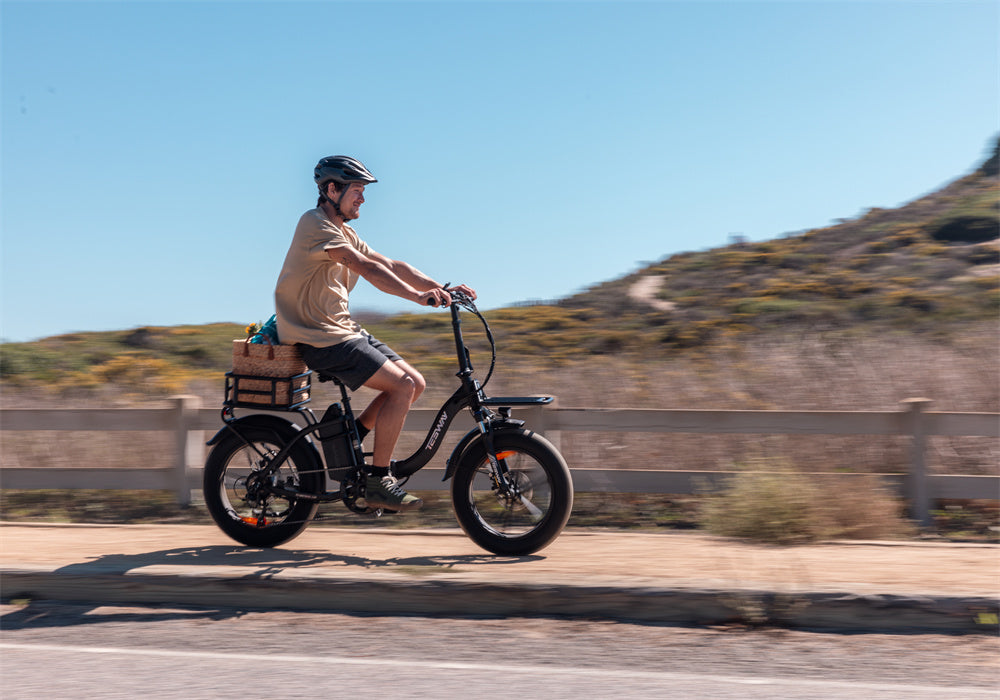Electric bikes have revolutionized the way we commute and enjoy outdoor adventures, offering convenience, speed, and a smooth riding experience for both city and off-road cyclists.
Proper tire pressure can improve handling, reduce the risk of flats, and make your ride more comfortable.
Tesway electric bikes feature puncture resistant tires, providing enhanced durability and resilience for a worry-free ride on any terrain.
Importance of Proper Tire Pressure
Properly inflated tires affect almost every aspect of the biking experience, from speed and comfort to safety and efficiency.
When the tire pressure is too low, you risk increased rolling resistance, which can make your ride feel sluggish and wear out the battery faster.
Low pressure also makes your ebike more susceptible to punctures, which can lead to flat tires.
Conversely, over-inflating your tires can make the ride feel harsh, reduce traction, and increase the risk of blowouts on rough terrain.
The right tire pressure provides an optimal balance between speed, comfort, and stability.

Finding the Right Tire Pressure for Your Ebike
Know Your Tire PSI Range
Each ebike tire has a recommended PSI (pounds per square inch) range, which is usually printed on the tire’s sidewall.
This range provides guidance on the minimum and maximum pressure levels, giving riders a base point to start with.
Road tires: Typically require between 80 to 130 PSI for optimal performance on paved roads.
Mountain bike tires: Designed for rough terrain and can operate effectively with 25 to 35 PSI.
Hybrid or commuter tires: Ideal for city riding with 40 to 70 PSI.
Adjust for Your Weight and Terrain
Lighter riders can often get by with lower pressures, while heavier riders might need to increase the PSI slightly to support their weight.
Additionally, different terrains require varying tire pressures. For smooth roads, a higher PSI will reduce rolling resistance, making it easier to maintain speed.
However, if you frequently ride on rough or uneven terrain, a slightly lower PSI will increase traction and provide a more comfortable ride.
SEE ALSO Which Battery Size is Best for Your E-Bike Performance
How to Check Your Ebike Tire Pressure
Checking your ebike tire pressure is a simple process, but it should be done regularly.
Even the best ebike tires lose air over time, which can impact ride quality and safety.
Use a Pressure Gauge
A high-quality tire pressure gauge is a must-have tool for any ebike owner.
Most floor pumps come with a built-in gauge, but a dedicated tire gauge can provide more accurate readings.
Simply attach the gauge to the valve, and you’ll get an immediate reading of the tire’s current PSI.
If it’s below the recommended level, it’s time to pump it up.
Check Before Each Ride
The best practice is to check your tire pressure before each ride or at least once a week if you ride frequently.
A quick pressure check can save you from a potential flat or other tire issues that could leave you stranded.

Adjust Tire Pressure Based on Riding Style
Your riding style and preferences play a crucial role in determining the ideal tire pressure.
Road and City Riding
For city or road riding, higher tire pressure is often ideal as it reduces rolling resistance and enhances speed.
Higher PSI makes for a smoother, faster ride on paved surfaces and can help preserve battery life by reducing drag.
Off-Road or Rough Terrain
If you often venture onto trails or uneven surfaces, lowering your PSI slightly will increase traction and provide a more stable, comfortable ride.
Lower pressure allows the tires to absorb more of the impact from rocks and bumps, improving your handling and reducing strain on the bike’s frame.
Wet or Slippery Conditions
In wet weather, reduce your tire pressure slightly to improve grip and control.
Lower pressure increases the surface contact of the tire, providing better traction on slick surfaces.
Avoid Over-Inflation and Under-Inflation
Maintaining a balance between under-inflation and over-inflation is crucial.
Risks of Over-Inflation
Over-inflated tires can make the ride feel bumpy and uncomfortable, reducing grip and making it harder to control the ebike on rough terrain.
High PSI can also increase the risk of tire blowouts, especially on uneven roads or trails.
Risks of Under-Inflation
Under-inflated tires create more resistance, causing the ebike to use more energy and, consequently, draining the battery faster.
Low PSI also increases the risk of pinch flats, which occur when the tire compresses against the rim due to low pressure.
In addition, it can lead to premature tire wear, which means you’ll need to replace your tires more often.
Tips for Long Term Ebike Tire Maintenance
Regular maintenance can help prolong the life of your ebike tires and improve your overall riding experience.
Inspect for Damage Regularly
Check your tires for any visible damage, such as cuts, bulges, or worn-out treads. Even small punctures can lead to larger problems if left untreated.
Rotate Your Tires
Just like car tires, ebike tires can benefit from rotation to ensure even wear. If you have an ebike with removable tires, consider rotating them every few months, especially if you notice uneven tread wear.
Keep Tires Clean
Keeping your ebike tires clean helps to maintain good traction and reduces the risk of punctures. Dirt and debris can accumulate on the treads, potentially affecting grip and performance
How to Properly Store Ebike Tires
When not using your ebike for an extended period, storing the tires correctly can prevent them from degrading.
Clean and Inspect Tires First
Before storage, clean each tire thoroughly to remove any dirt or debris. Check for any damage, and ensure that the tires are dry before moving them into storage.
Store in a Cool, Dark Place
Exposure to sunlight and fluctuating temperatures can weaken the rubber of the tires. Store your tires in a cool, dark area, ideally in an airtight plastic bag, to reduce exposure to humidity and UV rays.
Inflate Slightly for Storage
If you plan to keep your ebike in storage for several months, inflate the tires to about half of their usual PSI. This prevents the tires from going completely flat and reduces the chances of cracking due to pressure changes.
FAQs
How do I know if my ebike tires are over-inflated?
If your ride feels unusually bumpy and you struggle to maintain control, your tires might be over-inflated. Use a pressure gauge to check and adjust the PSI if necessary.
Does tire pressure affect my ebike battery life?
Yes, low tire pressure increases rolling resistance, making the motor work harder and draining the battery faster. Properly inflated tires can help extend battery life.
What should I do if I experience frequent flats?
Frequent flats can be caused by low pressure, sharp debris, or worn-out tires. Check your PSI, inspect the tires for damage, and consider upgrading to more durable ebike tires if the issue persists.






Share:
TESWAY’s Black Friday Sale: Unbeatable Deals on Long-Range Electric Bikes!
Reasons Why Electric Bikes Are Perfect for Seniors